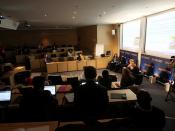There is a far-reaching problem in the Arizona community. Despite the draw of sunny weather and beautiful landscapes, the state is unable to attract enough brainpower to fuel the economic climate. Arizona definitely has the potential to be a major player in the new knowledge and idea-based national economy. Currently ranked 10th in the nation for progress into the New Economy (The State Economic Index), Arizona supports seven high tech clusters, one of which, optics, has been "a world model in cluster economic development" (Barber). However, this situation is ephemeral. Pima County, especially, is struggling to keep high tech businesses in the area due to a lack of the most crucial commodity of this New Economy: highly skilled and trained human beings. To secure solid economic footing for the future, it is essential that Arizona invests in the establishment of these workers.
Past efforts to upgrade the workforce have been insufficient to propel Arizona into a leadership position.
The problem lies in that Arizona's human resources are not being fully utilized; too many individuals remain untrained for vocational improvement. This creates a self-perpetuating situation: there aren't enough workers to fill the entry-level jobs, and because of a sub-par educational system, those workers are not skilled enough to warrant promotion. Therefore, no sector of the workforce is without a scarcity of trained workers. To rectify this growing situation, Arizona must confront workforce development head-on and take immediate, but calculated action.
THE PRESENT PREDICAMENT
Already, the community has voiced concerns over the inadequacy of Arizona's workforce. Its development is dependent upon the cooperation among businesses, local educational facilities, and existing government programs.
Many large corporations have established themselves in the Tucson community, providing a plethora of high-tech jobs. Some of these businesses include Raytheon Systems, Bombardier Aerospace, Sunquest Information Systems, Honeywell, IBM and Texas Instruments. It is essential that these businesses work in conjunction with local schools to ensure that there are enough qualified workers to meet their needs.
Raytheon Systems, a major defense contractor, has tried combining its efforts with Pima Community College and the University of Arizona to help meet their particular educational demands. Through this collaboration, Raytheon is guaranteed competent local workers on a yearly basis. A stunning 5% of this country's engineering graduates are employed at Raytheon each year. Joseph Coyle, Vice President of Human Resources and Communications for Raytheon Systems explained the reason for Raytheon's success: they currently enroll employees and potential employees in 800 specialized courses both in-house and in collaboration with the University of Arizona and Pima Community College (Kolbe, et al). Raytheon's plan has succeeded in providing a pool of qualified workers for its own needs, but the plan is not universally feasible.
Sunquest Information Systems, a company that develops and supports clinical information systems, has taken a different approach to acquiring employees: they look beyond the local workforce. A large number of their employees need to be trained in specific technical fields, like systems specialization and computer science and languages. The problem that arises is that most of these skills are honed in the field through actual job experience, which make it difficult for a graduate student to jump right into the work force. Therefore, many out-of-state, even out-of-country employees are hired. Though Sunquest looks to the U of A's computer science department for potential employees, their lack of synergy with area schools forces them to search elsewhere (Vaughan).
The University of Arizona is one of the most important local resources for training qualified workers. Dr. John Taylor, Dean of the College of Education, coordinates the U of A's strategies for cooperative education and training. The U of A has established significant partnerships with local K-12 schools as well as with Pima Community College (Kolbe, et al). Although there have been several successful programs established, Arizona has fallen to 37th in the country for percent of adult population with a college degree suggesting that not enough workers have a comprehensive formal education (Muro). There are programs that accommodate the needs of those without formal education, allowing them to enter the workforce, such as ITT Technical Institute and the Fred Acosta Job Corps, however, high-tech companies usually require more than an associate degree for potential employees.
Pima County Community Services has developed workforce training programs that offer opportunities for low wage workers to acquire the skills necessary for higher paying, high tech jobs. High Tech High Wage is the newest of these programs, offering people, currently with jobs that have little chance of advancement, training for entry-level positions at high-tech businesses. Dare To Care, Reach to Teach, Welfare to Work, and Train to Gain are all similar programs that offer a quick fix by displacing the problem by one rung. These programs aid the individual, but do not create the pool of skilled workers necessary for a healthy economic structure.
SCHOOL-TO-WORK
Perhaps the most promising solution to growing workforce shortages is the idea of vocational training within schools. Many of the problems associated with the workforce come in the transitional period from the end of high school to entrance into the workforce. This idea of partnership between schools and businesses was significantly explored during the Clinton administration. The School-to-Work Opportunities Act of 1994, provided venture capital to states in order to strengthen the transition from school into work. Arizona was awarded $23 million over five years -- later extended to a six-year appropriation -- to implement workforce development programs (Morrison 2). The School-to-Work initiative was designed to give students a directed education, bridging the void between student life and the working world. As the Morrison institute states, "The underlying goal is to provide students with knowledge and skills that will allow them to opt for college, additional training or a well paying job directly out of high school" (National School-to-Work Office, 1/30/01).
In 1997, the program's goals were re-aligned: system governance and partnership, coordination and integration, technical assistance, community involvement, public awareness and system evaluation (Federal Register Part VI, 1995). Over the previous four years of program implementation, problems have emerged. The greatest deficiencies lie in "coordination and integration:" designed to guide K-16 programs and actually implement the School-to-Work program. One part of this goal was to create universal access to School-to-Work by implementing it statewide and actively engaging all schools in the program. Despite some positive results, especially the increase job market knowledge in 7th and 10th graders, School-to-Work was not implemented in all Arizona schools. The excluded schools attempted to make up the difference with clubs such as DECA, which helps students locate jobs, but don't adequately assist in job acquisitions (the underlying goal of School-to-Work). Although the general awareness of the program has increased in recent years, these holes in the program have generally weakened its effectiveness.
Why was there such an oversight in what was considered to be a comprehensive program? One reason is that implementation of School-to-Work varied considerably across the different partnerships (Morrison 20). Each school and business partnership was free to develop its own system of implementation and grant appropriation. While some flourished, expanding far beyond their original levels, others were unable to align their programs for effective implementation. Underlying everything was a consistent dearth of funding, which has slowly crippled the School-to-Work concept. Of the $23 million in funding, only $19 million was distributed to the partnerships. Using this figure, the amount each school received for the project averaged less than $4000 per year (Morrison 20). It breaks down to approximately $5 per student, not a substantial sum. It must be noted that despite the obvious lack of funding, School-to-Work had a significant impact, a testament to the concept's strength.
The problems in School-to-Work seem to be procedural and not conceptual. Ninety percent of employers reported that they would like to see more funding for School-to-Work, but only twenty percent of employers in the state were involved in the program (Morrison 16). This implies that the plan was either not well funded or not well implemented. But, given the high rate of success on 7th and 10th graders that did have access to the program, the shortcomings should mostly be attributed to a lack of funding.
THE MOVE TO IMPROVE:
A Three-Pronged Plan
After evaluating the past and current federal, state and local workforce development programs, several problem areas presented themselves. Despite the effectiveness of certain initiatives, such as School-to-Work and job training for specific businesses, the supply of qualified workers is still far from satisfying the demand. To resolve this situation, Arizona requires change on three fronts: a focused collaboration with Latino students and workers, a comprehensive marketing campaign to students at large in Arizona and an increase/renewal in funding.
"LATINO LINK"
Arizona has a very unique and challenging responsibility as a border state. In Pima County, alone, a little more than half of the young adult population is of Hispanic origin. A failure to bring this valuable resource into the New Economy workforce spells certain economic stagnation for the state as well as for the nation. Arizona must take action to target this valuable group, especially now that bilingual education has been terminated in Arizona's public schools. Our program, entitled "Latino Link," will connect Hispanics to the local high tech job market by reaching them while they are still students in our public schools.
Unfortunately, a large percentage of Hispanic Americans don't even graduate from high school. And even though this percentage usually decreases in the second or third generation of Hispanic Americans (Muro), the constant influx of immigrants impedes the overall improvement on this front. The concept of "Latino Link" is to improve the vocational and linguistic ability of Hispanic students while they are still in high school so that they can either progress to higher education or move directly into entry-level jobs with the prospect of advancement.
The educational components of this program would include basic math and reasoning skills, an introduction to simple computer languages such as BASIC and C, a basic course on how computers operate, and, perhaps most importantly, an ESL class to fine tune English speaking skills. After all, ideas and innovation play a key role in the New Economy, meaning students need to have better communication skills.
The program's goal will be not only to educate Hispanics, but also to link these potential workers to appropriate occupations. A committee containing concerned business-people and school administrators will direct the program and its curriculum. If the program can succeed in educating Latino individuals and connecting them to the workforce, Arizona will have a tremendous advantage in the years ahead.
OUTREACH TO ARIZONA
In addition to specifically targeting Hispanic Americans, Arizona must make an effort to incorporate all students into the workforce development system. Beyond an education and footing toward college, high school should provide every student with the opportunity to explore local businesses and experience the workforce before they become a part of it. As can be seen, many programs already exist to assist students as they progress through school and after they graduate, but most students are entirely unaware of these opportunities. The blame must not be placed on students for their lack of awareness, but rather on the businesses, training centers and government programs that inadequately publicize their existence.
What seems to be the most effective way for students to get their feet wet in the business world is through professional internships while they are still in high school. Internships provide students with a insight into the realities of vocational fields and many times excites them about a particular local company or simply about pursuing that particular field.
Our internship proposal is one that is similar to actions already taken by other states. Each school district would grant a 2-month period to students at the end of their graduating year where they could leave their tradition school obligations in order to take internships. These experiences would be counted for academic credit corresponding to the field in which they intern. This is one way to get students out into the job market early and a way to get businesses involved in our local schools. It is free publicity for businesses, and is advantageous to the lives of all the students who participate. Partnerships like these are crucial to developing a strong workforce.
It must be reiterated that these programs must be proactive if they are to succeed. Students cannot be counted on to seek out opportunities; rather business and training programs must come to students. Through wide spread publicity campaigns -- publishing information for students to explore, to be distributed through their schools, and by advertising opportunities in mass media -- students will be enticed to explore their opportunities. This, combined with a scholastic program to give student vocational experience, will provide Arizona with a base of students, informed about their possible futures.
FUNDING: The Key to Success
The most destructive problem to current programs, and those we have proposed, lies in the source of their funding. Inadequate funds are appropriated to fueling workforce development in Arizona. Even as legislation such as Proposition 301 is passed to improve education, the issue of workforce development remains untouched. Proposition 301 provides for K-12 funding, with a particular focus on teacher compensation, but utterly ignores the student experience beyond high school. The state must not abandon its students after they've donned their cap and gown. Support must guide these graduates into the workforce.
The federal government addressed this issue with the School-to-Work Opportunities Act of 1994, providing funding to Arizona for workforce development. Unfortunately, Arizona's appropriations expire in December 2001 and no other federal funding has yet been secured. Arizona's first action must be to try to secure more federal funds. Regardless of the success of this effort, additional in-state revenue must be allocated to workforce development, and the efficiency of existing programs must be improved so that each dollar makes a difference.
As seen with the success of Proposition 301, funding for students is popularly supported in Arizona. This support must be broadened to include a student's assimilation into the workforce. A new proposition must be initiated to fund all current and future programs. A very slight increase in sales taxes, as little as .05%, could bring in millions of dollars for workforce development, an integral part of Arizona's economic future. Although some may oppose an additional sales tax increase, no one can deny the need for workforce development.
However, funding is useless, if there is no collaboration and/or consolidation of the many existing programs. The abundance of individual organizations, though seemingly positive, in fact is a barrier to effective workforce development. Many programs work independently with little cooperation or communication, creating an utterly inefficient system. Programs with similar participants and goals should combine their resources to create a network of cooperation throughout the state. Such a network should then be organized under a body that can regulate and direct efforts. The Arizona Partnership for the New Economy (APNE) initiated by Governor Hull, is a preliminary step toward this goal, but this won't be effective without an organized underlying framework.
Funding is the key. Without it we risk squandering our human resources -- perpetuating the cycle of an under-trained and under-staffed workforce. Funding is the most significant component of our proposal, but is potentially the most controversial. There should be no controversy over Arizona's future; if Arizona is too succeed in the New Economy, additional funding for workforce development must be accrued and apportioned intelligently, otherwise Arizona faces a grim future of economic mediocrity.


